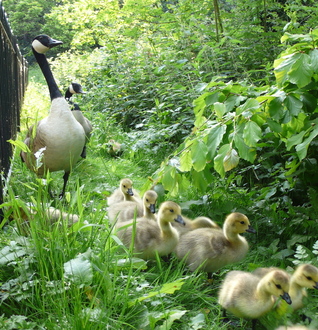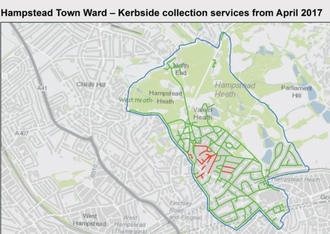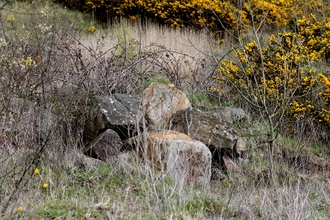-
Homes for people - Homes for wildlife.People are increasingly concerned about the pressures on wildlife. Especially in cities like London, many beloved species, such as hedgehogs, sparrows and bumble bees are all visibly declining. The 2016 State of Nature report found that 7 per cent of urban wildlife species are nearing extinction. [link: http://www.rspb.org.uk/Images/State%20of%20Nature%20UK%20report_%2020%20Sept_tcm9-424984.pdf], and the number of hedgehogs living in London has dropped by half since 2000. [link: https://www.london.gov.uk/sites/default/files/at_home_with_nature_-_encouraging_biodiversity_in_new_housing_developments.pdf] People want to help but can an individual make a difference? We believe they most certainly can, if this scheme receives the backing of the Mayor of London. Every month in London thousands of homes are bought and sold. The commissions are considerable, and every home letting involves fees paid to the agents too. But what if a tiny proportion of these commissions were set aside to enable the new householder to buy a bird box, a bat box, bee-friendly plants or something else to encourage wildlife in some way? Its a simple concept - Homes for People - Homes for Wildlife! The home’s new owner could chose which sort of measure to encourage wildlife would work best for them and gradually a whole new range of safe and secure wildlife homes would spread across the city. Such a project has national potential but needs someone with the Mayor of London’s credibility to help get the various bodies, like the National Association of Estate Agents on board. They have always been painted as bad guys but we can give them the chance to do some real good with this scheme, by making it simple for people to give homes to nature. If done in an imaginative way, for example by making the voucher a unique token like a coin, redeemable with companies or organisations that sell wildlife-friendly products, the scheme could be expanded in use. Other companies wanting to help people support wildlife could also buy and give away ‘eco-crowns’ and people could pass them on if they can’t easily use them in their own homes. We could even have a competition, engaging with schools, to help design and name the ‘eco-crowns’ and another for product designers, to decide on the material (re-cycled plastic?) and ensure that the coins could not be forged. Before all this, the first step, is to get people like the London Assembly and the Mayor to see the benefits and back the concept, and then win the involvement of national bodies like estate agents as it gains wider support. Please sign the petition and help get my idea off the ground. This campaign was started by Maurice Melzak, a zoology graduate, naturalist and documentary film maker for more than 30 years. He first developed the idea in 2010, for Waterlow Park, where he gained the support of a local estate agent and a nesting box manufacturing company. It was featured on the BBC’s Springwatch. Maurice volunteers at Highgate Cemetery where he keeps honey bees and advises on wildlife issues. He obtained a Biffa landfill grant to purchase over 100 bird and bat boxes for the Cemetery which has made a significant difference to the bird life in the surrounding area. (see pic). With the need to save urban wildlife even more urgent, with a new Mayor and new support from politicians, he hopes this petition will get it off the ground and start to make a difference soon.195 of 200 SignaturesCreated by Maurice Melzak
-
Transform Recycling in Winchester & HampshireIn 2015 we managed to recycle a meagre 35%, while the best performer, South Oxfordshire, achieved 65%. We’re in the bottom 20% of councils in England. You may be wondering if it really matters that much. The truth is that it matters a great deal. Waste is one of the most significant contributors to climate change, contributing a similar amount of carbon as aviation. Many councils across the UK have been recycling more types of waste for years now. Hampshire never evolved, offering the same recycling service as it did 20 years ago. So, whilst many councils have been able to double or even triple recycling we have achieved minimal gains. Hampshire needs to shift emphasis from incineration and collect more types of waste for recycling. Research suggests that in Winchester if all plastics were collected it could increase our recycling rate to 40%, glass 45%, food waste a staggering 63%. Also, if the council did more to encourage residents to recycle correctly we could increase our rate to 66%, placing us in the top five performing authorities. Let’s play our part in reducing greenhouse gases from waste and at the same time give our city something else to be proud of.190 of 200 SignaturesCreated by James Miller, Dirty Money Campaign
-
Bantham 2017: stop the proposed development of Bantham village and beach.When Nicholas Johnston bought the Bantham estate, much against the wishes of most locals, he promised that he would leave it untouched. Now he is proposing to develop both the village and the beach, even going so far as to say that he will not be making the new housing affordable for local people (which, in a part of the country that has some of the most unaffordable housing available, should be a priority for any development, rather than lining the pockets of a man who has already proven he has no love for the people born and bred here). This is completely unacceptable to those of us who have enjoyed Bantham in its current form for so many decades, but more importantly to the people who live in the village. The infrastructure around Bantham village struggles as it is, this development would make a bad situation worse, in particular for the existing village residents, especially during the summer months. This Old Etonian, multi-millionaire friend of David Cameron, who has more than enough to survive on already, should not be allowed to profit from developing an unspoilt gem in our coastal countryside, especially when his proposals offer absolutely nothing for local people. You can read about his plans here... http://www.dailymail.co.uk/news/article-4216762/Millionaire-bought-village-plans-transform-it.html Please note that I have no legal training, I have started this petition in the hope of showing the authorities that there is a depth of feeling against such inappropriate plans for a much loved local beauty spot. Please share this petition with as many people as possible, especially with people from the Bantham area and wider South Hams. Thank you for your support.12,381 of 15,000 SignaturesCreated by Chris Jones

-
NO FRACKING IN DERBYSHIREFracking has been proposed in the area of Eckington. The people of the area do not want fracking to occur due to the damages that are linked to it such as Sink Holes, pollution to the water table, heavy plant traffic on small B roads and the eye-sore that it will cause to the local area.305 of 400 SignaturesCreated by Ismail Mir
-
Save Martin Mere from FrackingMartin Mere is a unique bird sanctuary of international importance and is located in a designated Fracking zone under PEDL licence 165 (south). Fracking in the vicinity of Martin Mere with dangerous chemicals and explosives used in this process would destroy the delicate infrastructure that has made Martin Mere the unique bird and wildlife sanctuary that it is today. As Fracking progresses in Lancashire from the Fylde downwards Martin Mere will soon face destruction unless public outcry makes the government make this an exclusion zone.1,103 of 2,000 SignaturesCreated by Brian Young
-
What a load of rubbish - Call for Camden Council to change its decisionFrom the residents who are signatories to the petition who live in the following wards and who are affected by the rubbish decision of Camden Council which starts in April 2017: Frognal and Fitzjohns, Swiss Cottage, West Hampstead, Belsize, Gospel Oak, Hampstead Town, Highgate and Kilburn Background Camden Council under the guidance of Cllr Merik Apak has decided, in its wisdom, to remove weekly bin collections for most of residents of the wards listed above. Not all roads in those wards are affected but most are. See the Ham and High’s article confirming those affected wards. http://www.hamhigh.co.uk/news/environment/revealed_the_camden_streets_to_receive_fortnightly_rubbish_collections_1_4842664 If you are not sure if you are affected, you can check your postcode at the link below to see whether you have weekly or bi-weekly collections: Post code checker http://www.veolia.co.uk/london/services/services/north-london/camden/service-change-checker This decision raises a peculiar situation where residents in the same ward with roads which adjoin each other have different rubbish collection dates. The rationale for the decision has been to boost recycling. Camden states that it will still collect recycling and food waste every week. In a letter in the Camden New Journal, Cllr Apak states “for those homes that have been independently assessed to have enough space to store rubbish for two weeks, we will collect their non-recyclable rubbish fortnightly, from April 1 onwards”. Space outside homes have, therefore, been allocated as storage sites for Camden’s waste. If you have the space to store such rubbish, you are chosen. See para 1.4 at the link below: http://www.camden.gov.uk/ccm/navigation/environment/recycling--rubbish-and-reuse/our-new-environment-services-contract/ This decision has nothing to do with the suggestion that residents who do not currently recycle are encouraged to do so. If you live in one of the lucky wards still to receive weekly collections, there is no incentive to recycle – you will still have weekly collections. If you live in one of the unlucky wards, and already recycle - there is no pat on the back – it matters not because you have been selected anyway for 2 weekly collections. Unless you opt out, Camden will now distribute a 240 litre capacity black wheelie bin which you must keep within the boundary of your property. If you already have a large Camden green recycling bin, you now need to add a black one of the same size to your garden. You can opt out of receiving the wheelie bin by 18 Feb. And, the sting in the tail is that if your household rubbish exceeds the size of the new wheelie bin or, if you don’t want one, the 4 Camden orange bags they will give you to put your rubbish in for collection, they won’t take it. Once your orange bags are emptied, you have to put any extra rubbish in them and store for another two weeks or take independently to Camden’s local recycling sites – see para 2.3 of the link above. So Camden is not just moving to 2 weekly collections, they are limiting the amount of rubbish they will take away. So, if you recycle but are a large generator of rubbish – too bad – you have to store it for longer or take it to the dump yourself. What are we paying our Council taxes for?? As part of the same plan, garden waste will now be collected every Saturday as a paid-for, opt-in service. Residents who subscribe to the service will pay £60 for 9 months or £75 for a year – but there is also the option of heading to centres at Hornsey Street or Regis Road to drop off garden waste for free.422 of 500 SignaturesCreated by Jessica Learmond-Criqui
-
Use Veggie, biodegradable bags in place of plastic.These biodegradable bags can replace plastic bags and they dissolve in hot water in minutes and in cold water in about 24 hours. They can be eaten by farm animals and wildlife animals with no ill effects. They also have no adverse effects if eaten by humans. This will do away with all the damaging effects of plastic bags that blow around all over world (land, rivers and sea). The cost of these biodegradable (veggie bags) is the same if not cheaper than plastic bags.21 of 100 SignaturesCreated by Gerald Lewis
-
Stop the Tip - Save the VoidThis site is now a unique wild life habitat containing a rich mosaic of grass and shale. It would be nigh on impossible to replicate what nature has produced here. Leaving aside wildlife, the real threat from this application is to the health and well being of local residents which is very serious. The nearby M1 motorway is having a speed restriction imposed to try to reduce high pollution levels another 200 wagon (all diesel) movements a day from this site will only add to a that toxic mix.992 of 1,000 SignaturesCreated by Willy Lane
-
Say No to Wylfa BThe nuclear option for electricity is dirty and dangerous. On Anglesey lets focus on renewable to generate more jobs and a sustainable future without the risk to the locality and the planet, with no radioactive waste. Talk to the people of Trawsfynydd, they thought it was safe now look at all the families devastated by cancer, a radioactive lake and an eyesore there for a thousand years.681 of 800 SignaturesCreated by Richard Haig
-
We do not want GM foods to be sold in the UK from the US.Act to stop roundup used on crops.Leaving the EU and having a trade deal with the US means one thing for certain we will be buying foods that have been Genetically modified from the US and we will also be growing GM foods in the UK.Meat from the US like chicken and pork are produced on factory farms,and chlorinated chicken and pork fed with GMO grains.Bad for us it will give us cancer and bad for the environment.Moves are already afoot to grow crops here. http://www.dailymail.co.uk/sciencetech/article-4179870/Genetically-modified-wheat-grown-UK.html http://www.collective-evolution.com/2014/07/15/new-study-links-gmos-to-cancer-liverkidney-damage-severe-hormonal-disruption/ http://articles.mercola.com/sites/articles/archive/2016/09/24/transgenic-wars-gmo.aspx http://www.healthline.com/health-news/does-roundup-cause-cancer Cancer rates in the west are rising,it is said that from 1in 4 now i in 2 people will develop cancer.We are being bombarded with junk foods and added chemical to our foods but also our crops are sprayed with glysophate,a pesticide used on every crop non organically grown.This pesticide causes cancer and should be banned.We do not want GMO foods which are laced with this pesticide and we do not want it to continue to be legal to use this pesticide. Say No to Roundup(glysophate)and say No to genetically modified foods,sign this petition.131 of 200 SignaturesCreated by Katie Nikiforou
-
DRASTIC PLASTIC UKPlastic, is not the disposable, one use magic material we were led to believe in the 1950's. The miraculous cheap, lightweight, disposable, durable substance, was years later, discovered to be toxic, none biodegradable, and is having a huge global negative effect for both humans and animals. Plastic never disappears into nothing, it is always there, breaking down into small micro plastics, which attract toxic, harmful chemicals damaging all life on the planet including ourselves. Fish in the oceans, are consuming, these meaning that we are too. It's killing marine plant life which provides 70% of the earths oxygen, after all, the world is mostly blue, not green. We've produced more plastic in the past ten years than we have in our entire history with not even half of it being recycled. 8 million tones of plastic being put in the ocean a year. Other countries across the world are taking the lead with plastic bag bans, plastic cutlery and plates bans and the 'zero waste Europe' network installing plastic bottle deposit and recycling schemes, why are we so behind!? Further reading... FEW FACTS It’s a durable, versatile material ideal for many applications, however, over 50% of it is used once then thrown into landfills or the ocean. More than 8 million tons of plastic is dumped in our oceans every year 300 million tonnes are produced every year, producing more over the last ten years than during the whole of the last century. To produce one plastic bottle, it takes 6 litres of water. Which is six times the amount of water that’s going to be put inside it! Plastic production accounts for 8% of the world’s oil preserves. ENVIRONMENTAL IMPACT Fish in the north pacific ingest 12,000 to 24,000 of plastic per year. 97.5% of Laysan Albatross chicks (Sea birds) have plastic in their stomach causing death and potential extinction. The ratio of plastic to plankton in the Mediterranean Sea is 1 to 2. In the most polluted places there’s six times more plastic than plankton. 1 in 3 species of marine species are endangered from entangled in marine litter and ingestion. Plastics toxic emissions are damaging marine eco systems which are dependent on marine plants. These plants produce 70% of the earths oxygen and remove 40% carbon. This has resulted in over 405 dead zones in the world, 5000 sq miles of the gulf of Mexico almost devoid of life being one of them. HOW THIS EFFECTS HUMAN HEALTH? Scientific research has proven plastic releases harmful chemicals. Micro plastic in the ocean absorb high levels of pollutants and dangerous endocrine disrupting chemicals, which can cause cancerous tumours, birth defects, infertility, developmental disorders and anything else hormone related. Fish that we eat are eating these plastics meaning it’s getting into our systems as well. NOT DISPOSABLE You can never ‘throw plastic away’, it’s always there. Either in the form of a smog in the ocean, or shipped to different countries. Since recycling is not a very profitable market. China banned being sold plastic in 2016, so now it gets exported to places like India where people sort through endless rivers of rubbish to find pieces to sell. The rest makes it was down the river into the sea. WEBSITE REFERENCES http://www.greenseas.org/ http://www.plasticoceans.org/ https://www.5gyres.org/229 of 300 SignaturesCreated by Hannah Elizabeth White
-
Dog Fouling PrestwickThe seafront at Prestwick and the roads leading down to it are constantly fouled. This impacts on the whole community and gives a bad name to the majority of dog owners who take responsibility for their animals.146 of 200 SignaturesCreated by Elissa Wilson
Hello! We use cookies to improve your experience by providing insights into how the site is being used. Find out more.












